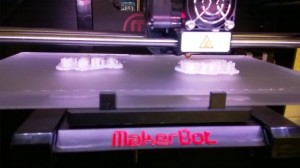2 weeks ago Smart donated a MakerBot 2 Replicator. Before I can figure out how a 3D printer might be useful in a chem, bio, physics, art class etch…I need to learn how to print. So for now, the learning will be about the details of how to print and what the capabilities are. Will it take many hours to learn to use the software? What kinds of parts are reasonable? Is learning how to use a 3D printer going to be a whole course all by itself? You do not have to know how an engine works to drive a car. How much of 3D printing do we need to know before we can make it useful for learning our various topics?
Is this a gimmick, or is it useful? At the moment, there is lots of excitement and lots of questions about how it works. There are lots of students who I have never seen showing up in my room. Students are going to get their friends and bringing them back to see it build. This is a fun first step.
I can’t wait until we are ready to take then next steps when we move from gimmick to innovation. .


It seemed fitting that one of the first things I print is a PEN for a SMARTBOARD. Turns out there is already a plan on Thingiverse for one. It works great on the old 600 capacitive series. Looking forward to trying it on the camera based boards.

The printer is doing multiple things at a time. Ends for a roof rack for the outdoor pursuits class, a bracket for a GPS unit for the upcoming outdoor pursuits bike trip, a cell phone case and a SMARTBOARD Pen.
About 2 hours into the 8 hour print, the filament fell out. I pushed it back in, but did not know how long it had been empty. Perhaps a layer or two. We decided to let it print anyway. It seemed to continue no problem. When we removed the items, there was a gap in the object. The printer printed almost into thin air. The connection was weak and it broke. However, we were able to use ABS cement on PLA plastics to glue ti back together.
Although this was a mistake, maybe it can print overhangs better than we think.

We needed a drain plug for our greenhouse. We could have gone to the local hardware store, but thought we should print instead. Again, we found this on Thingiverse. They worked like a charm.
Be side it is a mold of a lens for students to use on the presentation at the STEM Expo.
____________
So let’s try a molecule. Let’s try insulin. I found a pdb file for insulin, opened it in pymol, saved it as a V2RL file, opened that file in blender, saved it as a STL file. Then opened that in makerware. I chose to include raft and supports to make a 5 cm long model. I chose both the outer skin and the inside cartoon skeleton models. Print!!

This is the cartoon inside skeleton. It did the helix pretty well, but it is very thin. Pymol creates the cartoon model and has very thin connections representing the carbon chain from helix to helix. So when it printed on this scale the thin wires of carbon were not well done. I need to figure out how to “bold” the linking carbon chains. Double the scale will also help.

This is the outer skin of insulin on a raft and supports. The top looks a bit like a brain. The bottom is a bit hollow. After about 1.5 hrs of trying to clip off the supports, the bottom was still flat because of the supports. The supports were a real pain. If only they were dissolvable. I think a double headed extruder with a dissolvable filament would be very useful for chem.










